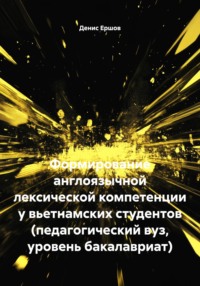
Полная версия
Английский язык. Полный курс
The same cognitive reason, due to the experience of human interaction with non-linguistic reality, lies at the heart of polysemy. Non-linguistic reality is reflected selectively by a person. He creates a specific model of the situation or scheme. The source of the word’s meaning is the situation. However, the word does not contain all the information about the situation it designates. This follows at least from the fact that the same situation can be denoted by different words. Thus, the members of the synonymous series represent the same action in different ways, highlight and emphasize different aspects and elements of the content of the situation. G.I. Kustova writes: «Let’s consider the synonymous series of get / take out / pull out (wallet from pocket). To get – emphasizes, emphasizes the distance to the object. Y.D. Apresyan defines this sign of the situation as «X is not directly within the reach of the subject’, cf. to get a book from the shelf, but not * to get it from the table (if we are not talking about a small child), from the table – to take… Overcoming this distance requires a person of some effort, from where the idea of the difficult achievability of the result arises, cf. got a deficit; I’ll get you anyway (threat); get you out of the ground. Take out – emphasizes that the object was in an enclosed space: take it out of the closet – from the shelf; take it out of the closet – * from the shelf. It also allows for enclosed space, but does not require it. Pull out – in addition to the same idea of moving from a closed space to a more open one as in take out (thanks to the prefix you-), emphasizes contact with the surface along the path of the object’s movement (due to the meaning of the root, dragging and – usually, but not always – heavy).
When you take your wallet out of your pocket, you «drag» it anyway, that is, you touch the surface, but getting it is a way of representing the situation that does not take into account this aspect of it, does not reflect, that is, there is no such sign in the verb to get, but in the situation it is. And, what is fundamentally important for us, he is known to man. If a person did not know that in the situation of «getting a wallet» there are aspects (elements, features) corresponding to the idea of «dragging», then he could not designate this situation with the verb to pull out. Therefore, the very fact of the existence of synonymy shows that a person KNOWS MORE about the situation than is «reported» in the verb… A verb in a certain sense, «choosing» only part of the information from a situation, gives a certain way of conceptualizing, understanding this situation – in other words, the verb is a semantic model of the situation, and, like any model, emphasizes something, highlights, if you like, sticks out, and darkens something, pushes it into the background the plan or even distorts it. Therefore, the other side of the coin is no less important – the remaining information that was not included in the «main», the original meaning (or in the assertive part of the meaning).
After all, the word, being a sign of the situation, connects a person with this situation. And although the word itself contains only part of the information about the situation, it PROVIDES ACCESS to a much richer and more meaningful information structure – a data bank, so to speak. And it is also a means of «realizing» the remaining information, «extracting» it and using it in derived values“ [Kustova 2004: 37—38]. Anthropocentrism in vocabulary also manifests itself in the inclusion of the „human dimension“ in the lexical meaning of the word, so to speak. Y.D. Apresyan argues that for many linguistic meanings, the idea of a person acts as a natural starting point. So, we estimate the size of animals, correlating them with the normal size of the human body. Elephants, rhinos and hippos are big animals because they are bigger than a human, and hares, cats, hamsters are small animals because they are smaller than a human. Yu. D. Apresyan: „I must say that the number of «anthropocentric» meanings in natural language is much greater than is commonly thought.
Another hour. Pierce, reflecting on such seemingly purely physical concepts as «heavy», «hard», «durable», admitted that they may include an idea of a person. In fact, what is HEAVY (about weight)? In our opinion, in the naive mind, the meaning of this word is associated not so much with body weight, but with the amount of effort that a normal person should expend to manipulate the corresponding objects – to shift them, lift them, transfer them. SOLID, in the first approximation, means «one whose surface is difficult to deform’, and DURABLE – «one that is difficult to destroy’. The question arises, what kind of force is thought of in these cases as a potential causative agent of deformation or destruction? One can, of course, assume that the nature of this force is indifferent, because a stone erupted by a volcano can deform the surface of an object or completely destroy it. Then it is necessary to remove the meaning of «difficult’ from the interpretations of the words in question, replacing it with a meaning like «rarely’ (deformed, destroyed). If we assume that the meaning of «difficult’ in the interpretations of adjectives SOLID and DURABLE is not accidental – and in fact it is not clear how one could do without it – then we have to admit that a person is thought of as the ultimate potential causative agent of deformation and destruction. It is clear that the «human factor» is also included in all evaluative words and in most words related to the concept of norm, because the system of norms is a human institution» [Apresyan 1986: 32—33]. Yu. D. Apresyan’s idea that the number of «anthropocentric» meanings in natural language is much greater than is commonly thought is also confirmed by our own observations on the «behavior» of the semantics of adjectives denoting, it would seem, «one hundred percent» objective signs of an object – iron, square, river, etc. For example, the meaning of the word iron is usually defined as «made of iron’, and this is correct.
But what about the following usage of this adjective: Did I come across some kind of iron box in the dark? The speaker, using this adjective, cannot know that the box is really made of iron (and not of cast iron or, say, steel). But he confidently chooses this designation because in his picture of the world, in his experience of interacting with non-linguistic reality, the «prototypical» metal is iron. Therefore, in reality, and in the meaning of the word iron, we must add an «anthropocentric coordinate» – iron: ’one that appears to the speaker to be made of iron.» The «human dimension» in the semantics of almost all nominative and even more deictic units of language naturally follows from the fact that, as G.I. Kustova writes, meaning is a «unit of storage» of information about the world. However, this is not all the information about the corresponding fragment of reality that a person has. To correctly interpret language expressions, a person must use a large amount of additional information that no one would think of reflecting in a dictionary: «For example, a situation» (person) sat on a horse» is interpreted as ’sat on the back of a horse’, although, apparently, in no «ordinary» dictionary to sit on a horse is interpreted as ’sit on the back of a horse’. Meanwhile, if a fly has landed on a horse, then it can be anywhere – on the head, on the leg, on the tail. To interpret the expression to get on a horse, a person must know how to ride horses, and the dictionary assumes that the person knows this. If a person boarded a train, he is in the carriage, if the birds boarded the train, they are on the roof. If someone painted a house with blue paint, it means that the walls are blue, not the roof; if someone ate an egg for breakfast, he ate the «inside», not the shell; if he cleaned his shoes, he cleaned the «top», not the sole, etc.» [Kustova 2004: 35].
Another aspect of the anthropocentric organization of vocabulary is related to the peculiarity of the functioning of so-called abstract nouns. It turns out that this is convincingly shown in the famous book by M. Johnson and J. Lakoff’s «Metaphors that we live by» (1980), in the conceptual system of man, most abstract meanings are metaphorically represented, embodied, in the form of a concretely sensual essence [Lakoff, Johnson 2004]. V.A. Uspensky in his work «On the substantive connotations of abstract nouns» argues that any abstract lexical unit in usage tends to be reified and in the context «behaves» exactly as a concrete one. So, authority can be dropped or put on the scales. This means that authority is represented in the human conceptual system as a «heavy object made of hard, unbreakable material’. Grief, for example, is a «heavy liquid’ (as it collapses, suppresses, presses down), and joy, on the contrary, is a «light light liquid’ (it overflows, overflows, overflows). When using the expression to eradicate evil, the idea is implied that evil has roots, and in the context of a ray of hope, hope is reinterpreted as a source of light [Ouspensky V. 1979: 142 – 148].
From the standpoint of linguistic cognitivism, the word appears to be the most important unit of language through which the world is perceived and conceptualized. In contrast to the logical direction, the word in cognitive linguistics is considered from the standpoint of «natural language», where the world is categorized in a special way. The features of the «natural language» categories are: 1) anthropomorphism; 2) orientation towards a stereotype (prototype); 3) vagueness and openness of the boundaries of the LZ; 4) reductionism; 5) lack of a hierarchy of features. LZ in cognitive linguistics appears as: 1) the representation of human experience in a schematic representation; 2) related to the human body and its properties; 3) having the character of a gestalt, frame, scenario. Semantics includes prototypical semantic connotations – these are signs attributed to the prototypical object of reality (or imaginary); they are not always confirmed by practice and are not reflected in the dictionary definition.Today, we will define the semantic field and discuss the structure of this field. 1. Definition of the Semantic Field: The lexical system, in all its manifestations, is most fully and accurately reflected in the semantic field – the highest lexical category.
A semantic field is a hierarchical structure consisting of a set of lexical units that share a common (invariant) meaning. These lexical units are grouped together based on the archiseme that unites them, such as «time» for all time expressions, «relative/relative» for all kinship terms, and «color» for all color terms. The semantic field is characterized by homogeneous conceptual content, so its «building blocks» are typically not words that relate their meanings to different concepts, but rather LSVs (lexical semantic variants).. Polysemous words often have different meanings (LSVs) in different contexts. For example, the word «sister» can be used to refer to kinship or medical personnel. The word «day» can also have different meanings, such as part of the day or all of the day. The concept of «field» can be absolute in its fundamental structure, but it can also be relative in the context of vocabulary analysis. It is usually limited to specific research tasks. In other words, the entire vocabulary can be organized into a hierarchy of semantic fields, or a thesaurus, which is an ideographic or onomasiological dictionary.
Large semantic spheres are divided into classes and subclasses, and so on, until they reach elementary semantic microfields.. An elementary semantic microfield is a lexical-semantic group (LSG), which is a relatively closed series of lexical units belonging to the same part of speech and united by an archiseme with more specific content than the archiseme of the larger field. For example, in the broad field of «human (homo sapien)», we can identify several LSGs that characterize various aspects of human intelligence: LSG1, which includes words like «mind», «thinking», «thought», «concept», «judgment», «reasoning», «inference», «analysis», and «understanding»; LSG2, which encompasses words such as «think», «ponder», «delve», «conclude», «analyze», «understand», and «comprehend»; and LSGZ, which contains words like «smart», «reasonable», «wise», «sensible», «judicious», «thinking (adj.)», and «sharp-witted». supported by speech errors – the substitution of elements from one micro-field and several micro-fields connected in a system. The model of semantic field developed by E. Kittai is worth considering. The model is based on the idea that the field is a structure formed through the relationship between concepts, which creates differences in meaning relevant to a specific language community.
This idea of relation between contrast and similarity within the linguistic field can be seen as the development of linguistic significance, according to E. Kittai. She explains that two units that were previously not thought of as contrasting can develop contrast relationships when they fall into the same semantic field. E. Kittai sees the semantic field as both a social and individual factor, as it is necessary for people to be able to understand each other through language. In order to understand language, members of a language community must be aware of the semantic fields that words belong to.. Our concepts may differ, but they can manifest themselves in similar ways in our actions. These differences become apparent in the semantic fields that exist within our conceptual network. The possible variability of these semantic fields is limited, at least partially, by the shared understanding of the linguistic community. These semantic fields serve as «points of reference» for everyone who speaks the language. The semantic fields known to members of a particular society encompass both broad content, which is inherent in the collective mentality of the society as a whole, and narrower content, which reflects the individual perspectives of each member. It is possible to relate the semantic field – or rather, the conceptual field that underlies it – to the conceptual system. Both the semantic field and conceptual system influence how we interpret the information we perceive.
The phenomenon of adapting concepts in a field is similar to the development of systematically acquired properties of elements within a system, including conceptual properties. This adaptation of concepts and the emergence of new features within them constitutes one of the mechanisms of cognition. Apparently, closely related to the semantic field is the concept of «cognitive field model,» which comes into play when a person encounters a word or object. Thus, the field serves as a model for perception and generation of information, as well as a method for studying this process.
The most significant structural relationship between elements within a semantic field is hyponymy, which is a hierarchical system based on the genus-species relationship.. Hyponymy is a relationship based on incompatibility between semantically similar lexical units. It is a property of words that refer to concepts with non-overlapping volumes. Hyponyms are included in the corresponding category of names. For example, words like «poodle», «Great Dane», «shepherd», «greyhound» and «spaniel» are hyponyms of the word «dog», which is their hypernym. These hyponyms have a hyponym-hypernym relationship with each other. Hyper-hyponymic relations structure the hierarchy of concepts from top to bottom and bottom to top.
The terms «hyponym» and «hypernym» are relative, meaning that the hypernym «dog» becomes a hyponym when it is placed at the top of a hierarchy, such as «animal». Based on the concept of hyponymy, related lexical units are consistently grouped into LSGs (lexical semantic groups), subclasses, classes, and classes of classes, forming a complex and multidimensional structure of connected semantic spheres. Of the essential properties of hyponyms that reveal the relationship between the elements in a joint venture, the following can be noted. Firstly, unlike synonymy, which is one of the significant semantic dimensions of a field, hyponymy is defined by one-way implication: it is always possible to substitute a hyponym for a hypernym, as the sum of the species under a genus (e.g., «He bought roses» can be replaced with «He bought flowers»). However, the reverse is not always true, as flowers may not be limited to roses. Secondly, the meaning of a hyponym is more complex and richer semantically than that of its hypernym, and the set of objects it represents is narrower. The relationship between hyponyms is that of elements within the same class.; Hyponyms include the semantic content of the hypernym and are opposed to each other by corresponding additional differential features; for example, physics, chemistry, mathematics, and linguistics are all hyponyms of the hypernym «science». The structure of the semantic field includes words of different parts of speech, which are characterized by not only syntagmatic and paradigmatic relations, but also associative-derivational relationships.
These three dimensions form the basis of the joint enterprise: 1. Native father, to love the father, the father of the family… 2. Father – mother, son, daughter, grandfather… 3. Father – paternal, paternally, paternity… (word formation derivation) Father 1 refers to a man in relation to his children, father 2 refers to an ancestor or founder, and father 3 refers to a minister of worship (a semantic derivation that connects the semantic field of kinship terms with adjacent fields). JV units can be involved in various types of semantic relationships. For example, the adjective «tall» as a member of the LSG «man» can be related to other words through hyponymy, synonymy, antonymy, conversion, word-formation derivation, and polysemy. The adjective «tall» can be used to describe someone’s height, as in «Ivan is taller than Peter,» or it can be used in a figurative sense, such as «highly gifted.» It can also be used in different meanings, like «yield,» «reward,» «style,» «quality,» and «tenor.» The associative-derivational relationships of polysemy help to connect this LSG to other LSGs in the «man» field and other related fields. However, not all words within a field necessarily participate in these semantic relationships. The noun «table,» for example, does not have an antonym. Despite the wide variety in the organization of semantic fields and the specifics of each one, we can talk about a fundamental structure of a joint venture. This structure assumes the presence of a core, center, and periphery.
Let’s take the «transfer» field as an example. We will limit ourselves to verbs that form the basis of this field for the sake of simplicity. The general meaning of the field, in its «pure» form, contains the simplest word: «to cause someone to start having something»: She hands him the book. The verb «to transmit», together with words similar in meaning (such as «to hand over» – «to transfer directly from hand to hand»), forms a class of non-specialized transfer units – the core of the semantic field. This nuclear part of the joint venture is enveloped in specialized classes of transmission, where the overall value of the field becomes more complex as it moves away from the core. These classes represent the center of the semantic field, including «donation,» «purchase and sale,» «payment and loan,» «testament,» «forwarding and transportation,» «transmission of information through communication channels,» and others. By virtue of the law of asymmetry between sign and meaning, semantics of transmission can also be expressed through units from other adjacent fields on the periphery, indicating the close relationship between semantic fields in the lexical system of language.. Verbs with the meaning of making, preparing, or creating something in specific contexts that implement their secondary semantic functions, can denote the act of transferring or giving something: «Parents built a cottage for their children» (meaning they handed it over or presented it); «The mother peeled an orange for her little son» (meaning she peeled it and gave it to him).
For JV units (which I’m not sure what these are), it is often possible to indicate their syntagmatic and paradigmatic properties that are correlated with each other. The verbs mentioned above are characterized by a general basic distribution pattern: N1VN4NZ, where N is a noun in a specific case (N1 – Nominative, N2 – Dative, N3 – Accusative), and V is a verb that denotes transfer. For example, «The dean presents a diploma to the graduate» (cf. a modified version of this formula where the semantics of the verb is more complex, such as «to sell» – «to give in exchange for money»: N1V'4NZ, e.g. «He gives me a book for a ruble»). The units of the semantic fields «man» and «tools» are characterized by the construction N1VN5, with various extensions. For example, «I heard it with my own ears», «he grabbed the crossbar with his hands», «they shovel snow with shovels», etc. The substantial compatibility of these field units reflects their paradigmatic proximity and semantic community. For example, to give is «to give a gift» and to sell is «to give for a fee». These words appear in the lexicon in all their characteristic connections and relationships, which are actually present in the lexical system of the language. The lexical categories mentioned above are interconnected and juxtaposed within the field as its most significant components. These categories are synthesized within the field.
The «picture of the world» that a language reflects is not the same for all people, which means that the principles of how they categorize reality are different. This difference is reflected in both the vocabulary and grammar of a language. Therefore, when learning foreign words, a person is extracting pieces of a puzzle from a picture that is still unknown to them and trying to combine them with their existing worldview. With each new word, a new concept from another world is being «transposed» into the student’s mind. This «transposition» is often the stumbling block that poses a significant challenge for both teachers and students of a foreign language. The lack of attention paid to establishing the important connection between native and foreign conceptual worldviews is what impoverishes the vocabulary of those studying a non-native language. Thus, recreating a conceptual picture of the world inherent in a studied culture is one of the most significant tasks of foreign language educators. The view of philosophers who have contributed to the discussion of the issues of dialogue between cultures and civilizations is that one should not attempt to survey a vast sea of facts but rather focus on the essentials, i.e., try to understand the core socio-cultural values of other civilizations where all these facts converge in the form of a socio-cultural framework. And A. Vasilenko rightly observes, «The space of dialogue among civilizations in today’s global world is filled with subtle socio-cultural impulses that are difficult to interpret using rational knowledge; their sources lie deep within the human spirit and the recesses of culture.» To address the issues raised in Cognitive Linguistics, researchers use conceptual analysis, conceptual or cognitive modelling, frame and prototypical analysis as leading methods. The focus on studying the various knowledge structures that underlie language use is driven by the need to identify «those common concepts that are summarized under one sign… known to the cognitive structure» as well as by analysing the content of concepts, or conceptual analysis.
The object of conceptual analysis are the meanings conveyed by individual words, phrases, standard propositions, and their implementation in specific statements, as well as in individual texts and whole works. The structure and content of different concepts (conceptual features) are revealed through the meanings of linguistic units that represent these concepts, their dictionary definitions, and speech contexts. A comparison of all available linguistic means of representing a concept in a language system and in speech allows us to identify the main content of that concept, as well as the principles behind the organization of linguistic material. This is because the formation of meanings of individual linguistic units, their various classifications, and the creation of language categories all depend on certain concepts.
Practice shows that different dictionaries often offer different definitions for the meanings of words. This suggests that the content of a concept is, in essence, uncountable. One method of studying concepts is through the field approach. In linguistics, a field is understood not just as a collection of vocabulary, but also as a method of research. L.M. Vasiliev, in his review, based on a large number of different fields, both well-known and less well-known, convincingly demonstrated the existence of the «method of semantic fields» in linguistic research. However, there is a view that the field is merely a research construct, with which one may disagree. Firstly, research shows that semantic fields and their relationships are part of the knowledge possessed by native speakers. This fact is evident in social interactions. It is also known that cultural differences between people correlate with different organization of linguistic fields. Secondly, the objectivity of the field is confirmed by speech errors – the substitution of elements of one microfield and several microfields of the semantic field connected in a system.











